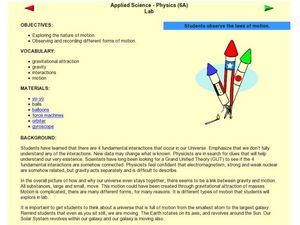Curated OER
Fossil Fuels (III), The Geology of Coal: Interpreting Geologic History
Young scholars hypothesize about why various samples of coal have different characteristics. Pupils use information that they found during Internet searches to ascertain the validity of their hypotheses and verify the "story" of coal. ...
Curated OER
Motion Experiment
Students experiment with the laws of motion. In this motion lesson, students explore Newton's Laws of Motion. Students work in groups experimenting with different objects and observing different types of motion.
Curated OER
Our Changing View of the Earth
Students explore the theory of Plate Tectonics. They participate in a simulation in which they re-enact the debate over Plate Tectonics vs. traditional beliefs of stationary continents that were widely accepted during the 1800's and...
Curated OER
Graham Cracker Plate Tectonics
In this plate tectonics worksheet, students use Graham crackers, frosting, water and a paper plate to simulate tectonic processes such as convergent, divergent and transforming plate boundaries.
Curated OER
Exploring Hurricanes
In this hurricane worksheet, students explore the behavior of hurricanes by reading an article about it. They complete 8 short answer questions that follow.
Curated OER
Water Crossword Puzzle Worksheet
For this Earth science vocabulary worksheet, students read 14 clues pertaining to water on this planet. Students fit their answers in a crossword puzzle.
University of Colorado
Terra Bagga
Earth's magnetic poles switch positions about every 200,000—300,000 years. In the activity, groups create a planet with a magnetic field. Once made, they use a magnetometer to determine the orientation of the planet's magnetic field....
University of Colorado
Happy Landings: A Splash or a Splat?
Huygens spacecraft landed on Saturn's moon Titan in 2005, making it the farthest landing from Earth ever made by a spacecraft. In this hands-on activity, the 12th installment of 22, groups explore how density affects speed. To do this,...
Curated OER
Mesopotamian Gods: Handout
Ancient religion was often times closely linked to social structure and government. Hand out a handy guide that describes 12 major gods and goddesses from ancient Mesopotamia. They are each connected to a location, symbol, and force of...
Virginia Department of Education
Heat and Thermal Energy Transfer
How does radiation affect our daily lives? Answer that question and others with a lesson that discusses radiation and its use in thermal energy transfer through electromagnetic waves. Pupils investigate vaporization and evaporation while...
Curated OER
Candy Quakes
Eighth graders use candy to show the effects of deformation forces on the earth's crust. In this rock and fossil formation lesson students construct models and simulations to describe and explain natural phenomena.
Curated OER
Falling
Students should describe the path that the motion would take as well as what might begin or stop the motion. The common characteristic of all the motions that students have experienced directly is that one or more forces are acting on...
Curated OER
Newton's Law of Universal Gravitation
Pupils explore the nature and magnitude of gravitational forces. In this gravitation lesson plan students study gravity and answer questions.
Curated OER
I Don't Think We're in Kansas Anymore (Grades 2-5)
Learners give examples of erosion and weathering processes. They determine causes of America's Dust Bowl phenomena.Students define erosion as the condition in which the earth's surface is worn away by the action of water and wind.
Curated OER
Global Climate Change
Second graders investigate the effect of melting glaciers to sea level. In this earth science lesson, 2nd graders simulate the process in the lab by conducting an experiment using ice cubes and clay. They explain the consequences of...
Curated OER
Forces of Nature: The Challenges of River Travel
Students examine how river travel affected the Lewis and Clark expedition. They define gravity, slope, and velocity, conduct a river formations experiment, complete an activity sheet, and watch a video about Lewis and Clark.
Curated OER
How to Be "Naturally Attractive" (Without Even Trying)
Students examine the various properties of magnets, explain how a compass works and make an electromagnet. They also experiment with magnetic lines-of-force using paper and iron filings.
Curated OER
The Rifting of Pangaea and the Gettysburg Battlefield
Eleventh graders analyze and interpret an animated model of Earth’s rifting processes. For this Earth Science lesson, 11th graders connect Earth’s rifting processes with the Earth’s surface in the Gettysburg battlefield. Students apply...
Curated OER
Lesson: Sand and Water
Young scholars review background information about water tension and adhesive forces on sand. In this sand science lesson, students visit a beach and have a sand building competition near water and away from it. Young scholars discuss...
Curated OER
Earthquake
Learners view a video and conduct a problem solving activity to explain the effect different waves have on the earth's structure and what effect they have on different structures.
Penguin Books
Gulliver's Travels Teacher's Notes
Who are "the most pernicious race of little odious vermin that nature ever suffered to crawl upon the surface of the earth”? Readers of Gulliver’s Travels will learn the answer, as the journey with Lemuel Gulliver to Lilliput,...
Curated OER
Newton's First Law
In this laws of motion worksheet, students review vocabulary words and concepts associated with Newton's first law of motion. This worksheet has 15 true or false questions.
Curated OER
Magnetism
Students investigate magnets. For this magnetism lesson, students begin exploring magnets. Students study attraction and repulsion and discover the poles of a magnet.
Curated OER
Weather and Wind
Students study wind and its effect on weather. For this investigative lesson students write a report on wind and weather and create a movement sequence.

























